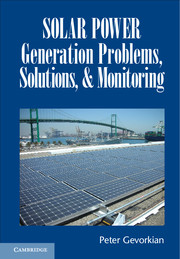Book contents
- Frontmatter
- Contents
- About the Author
- Foreword
- Preface
- Disclaimer Note
- Acknowledgments
- Peer Review of Solar Power Generation Problems, Solutions, and Monitoring
- 1 Types of Energy Sources and Energy Production and Use
- 2 Significance of Large-Scale Photovoltaic Solar Power Energy Production
- 3 Concentrator Photovoltaic Technology
- 4 Issues and Problems Associated with Large-Scale Solar Power Systems
- 5 How to Design and Specify Large-Scale Solar Power Systems
- 6 Solar Power Construction and Project Management
- 7 Solar Power Financing
- 8 Large-Scale Solar Power System Legal Issues
- 9 Proposed Advanced Photovoltaic Solar Power System Technology Requirements
- 10 Microinverters and Peak Power Tracking (PPT) Technologies
- 11 Advanced Solar Power Generation and Integration with Smart Grid
- 12 Large-Scale Energy Storage Systems
- Appendix A Glossary: Solar Energy Power Terms
- Appendix B Feasibility Study and Example
- Appendix C Solar Power System Tests
- Appendix D Bakersfield, California, Solar Power Fire
- Appendix E U.S. Statewide Solar Initiative Programs and International Tariffs
- Appendix F Alternative and Solar Power Engineering Studies Program
- Appendix G Historical Timeline of Solar Power Energy
- Index
10 - Microinverters and Peak Power Tracking (PPT) Technologies
Published online by Cambridge University Press: 05 March 2016
- Frontmatter
- Contents
- About the Author
- Foreword
- Preface
- Disclaimer Note
- Acknowledgments
- Peer Review of Solar Power Generation Problems, Solutions, and Monitoring
- 1 Types of Energy Sources and Energy Production and Use
- 2 Significance of Large-Scale Photovoltaic Solar Power Energy Production
- 3 Concentrator Photovoltaic Technology
- 4 Issues and Problems Associated with Large-Scale Solar Power Systems
- 5 How to Design and Specify Large-Scale Solar Power Systems
- 6 Solar Power Construction and Project Management
- 7 Solar Power Financing
- 8 Large-Scale Solar Power System Legal Issues
- 9 Proposed Advanced Photovoltaic Solar Power System Technology Requirements
- 10 Microinverters and Peak Power Tracking (PPT) Technologies
- 11 Advanced Solar Power Generation and Integration with Smart Grid
- 12 Large-Scale Energy Storage Systems
- Appendix A Glossary: Solar Energy Power Terms
- Appendix B Feasibility Study and Example
- Appendix C Solar Power System Tests
- Appendix D Bakersfield, California, Solar Power Fire
- Appendix E U.S. Statewide Solar Initiative Programs and International Tariffs
- Appendix F Alternative and Solar Power Engineering Studies Program
- Appendix G Historical Timeline of Solar Power Energy
- Index
Summary
Microinverter Technologies
Microinverter technologies shown in Figure 10.2 have been specifically developed for use in residential solar power applications. Their main purpose is to convert DC power generated from each module or a string (string-type solar power microinverters) to residential 240 VAC voltage. In addition to eliminating a single residential-type central inverter, the 240 volt AC power that is generated inherently prevents adverse effects of life safety and fire hazard that are usually associated with solar power strings’ high-voltage DC power.
Microinverters also have the capability to be turned OFF by wired or wireless communication commands; however, their response time is considerably longer than can be accomplished by the above-proposed photovoltaic (PV) submetering technology.
Due to the complexity of electronics, both peak power tracking and microinverter technologies, even though guaranteed for extended life spans, have shorter operational life cycles, and are PV-module-specific, which means that the products must have a variety of energy conversion performance characteristics that must be matched with specific types of PV module makes and types.
Another disadvantage of the above technologies is that cost of deployment of the units is quite substantial and cannot justify their economic use in multimegawatt solar power systems. Yet another drawback is complex electronics of the module, which makes them impossible to repair or test by maintenance personnel.
As a result of the above, these technologies, which have been on the market for nearly a decade have been deployed as of yet not in sizable multi-megawatt commercial grid-connected solar power systems. Figure 10.1 is a block diagram of a microinverter module deployment.
Enphase Microinverter
Located in Arbuckle, CA, Strain Ranches uses one of the largest farm-based solar installations in the United States to power its commercial rice drying and storage facilities. The 902kW ground-mount array features 3,760 industry-leading Enphase Microinverters matched with SolarWorld modules, which offset the ranch's electrical processing needs.
Biggest Installation
There is a 902 kW Enphase Microinverter system installed in Costa Rica. The owner's chose Enphase Microinverters over any other option for several reasons. They have a 25-year warranty; the system is installed on 5 structures, 4 of which receive some shading at some point in the day or year. Although the upfront cost is more expensive than string inverters, the higher output, better return on investment (ROI), and the ability to monitor the production of each individual module made these the best choice for our customer.
Information
- Type
- Chapter
- Information
- Solar Power Generation Problems, Solutions, and Monitoring , pp. 205 - 230Publisher: Cambridge University PressPrint publication year: 2016
